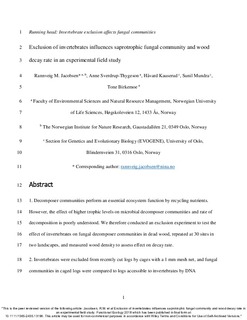Exclusion of invertebrates influences saprotrophic fungal community and wood decay rate in an experimental field study
Jacobsen, Rannveig Margrete; Sverdrup-Thygeson, Anne; Kauserud, Håvard; Mundra, Sunil; Birkemoe, Tone
Journal article, Peer reviewed
Accepted version

Åpne
Permanent lenke
http://hdl.handle.net/11250/2563583Utgivelsesdato
2018Metadata
Vis full innførselSamlinger
- Publikasjoner fra CRIStin - NINA [2364]
- Scientific publications [1392]
Originalversjon
10.1111/1365-2435.13196Sammendrag
1. Decomposer communities perform an essential ecosystem function by recycling nutrients. However, the effect of higher trophic levels on microbial decomposer communities and rate of decomposition is poorly understood. We therefore conducted an exclusion experiment to test the effect of invertebrates on fungal decomposer communities in dead wood, repeated at 30 sites in two landscapes, and measured wood density to assess effect on decay rate. 2. Invertebrates were excluded from recently cut logs by cages with a 1‐mm‐mesh net, and fungal communities in caged logs were compared to logs accessible to invertebrates by DNA metabarcoding analyses. Accessible logs included control logs, cage control logs and positive control logs. 3. We found that exclusion of invertebrates had a significant effect on fungal community composition. For example, the wood decay fungi Trametes versicolor and T. ochracea were significantly more abundant in accessible logs than in caged logs. The strongest effect on fungal community composition, however, was attributed to differing baseline conditions in the individual trees. When accounting for these baseline differences, caged logs had significantly higher wood density than control logs after 2 years, indicating lower rates of wood decay in caged logs. 4. Further studies, spanning several years, are required to fully understand the influence of invertebrates on fungi and wood decay. However, our results indicate that invertebrates influence both the composition of saprotrophic communities in dead wood and their decomposition function, which is vital to forest ecosystems. community assembly, dead wood, decomposition, DNA, high‐throughput sequencing, insects, saproxylic, top‐down